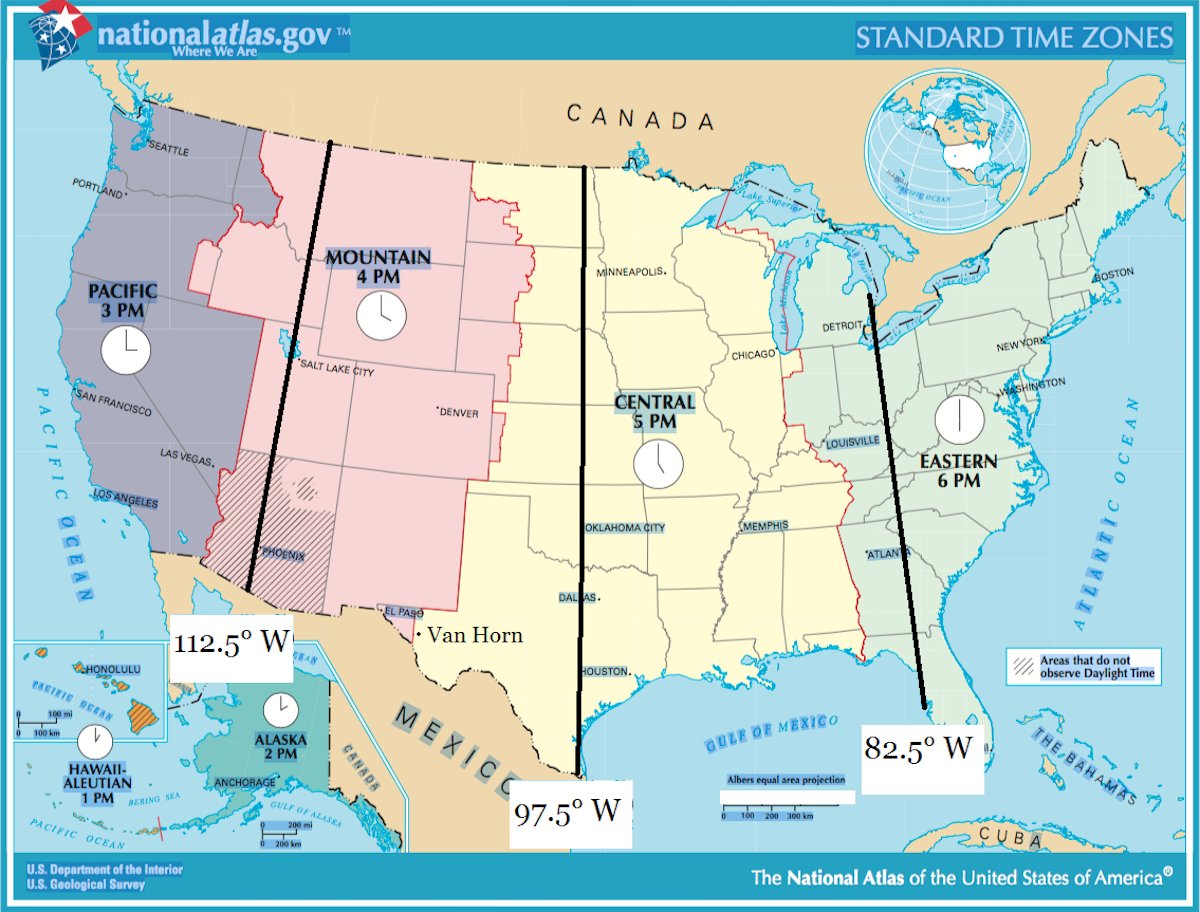
Resources for Students Daylight Saving Time: End it, don’t extend it!
 Blue lines show the meridians on which standard time is based. Dark red lines show half-way between them, where time zone boundaries belong. NationalMap.gov  The heavy black lines show where the boundaries of standard time zones belong. When Central Standard Time is observed, the clocks in Eagle Elementary School in Van Horn, Texas are 59 minutes and 21 seconds ahead of their local mean solar time. When Central Daylight Saving Time (which equals Eastern Standard Time) is observed, the same clocks are 1 hour, 59 minutes and 21 seconds ahead of their local mean solar time. The map scale has been edited. Who would want to use miles when you can use kilometers? What’s the big hurry? Why do bureaucrats force so many persons to observe a legal time so far ahead of their longitude’s mean solar time? Ending the time changes in March and November is an excellent idea, but that doesn’t mean they should adopt the wrong time year-round. Year-round daylight saving time requires an act of Congress. Year-round standard time can be done by State law. Gradual migrations of time zone boundaries produced the illusion that Maine belongs in the Atlantic Time Zone. That illusion is caused by the western boundary of the Eastern Time Zone being too far west, almost intersecting with 90° west, the reference line of the Central Time Zone. During daylight saving time, residents of Michigan’s Upper Peninsula are ordered to observe a legal time almost two hours ahead of their mean solar time. Notice how practically all of Michigan is closer to 90° west than to 75° west. Only a sliver of the Lower Peninsula, near Port Huron, belongs in the Eastern Time Zone. Minor variances, such as putting all of Michigan in the Central Time Zone, make life easier, but major shifts are supported by clods who think politicians can give them more hours of daylight. You cannot gain or lose daylight by changing your clock, any more than you can gain or lose weight by tampering with your bathroom scale. President Trump says he would be okay with the central government forcing all the States to observe daylight saving time year-round. If that becomes law, it will clearly represent the tyranny the Founding Fathers feared. In any case, legal documents, such as birth certificates, should specify what underlying time denomination is used. As used on this website, a place belongs on a time that is no more than 30 minutes away from its local mean solar time. A time zone boundary belongs where the local mean solar time is 30 minutes ahead of the standard time in the time zone to the west and 30 minutes behind the standard time in the time zone to the east. Obviously, minor adjustments are recommendable so that the actual boundaries do not run through Tampa, Florida or Oklahoma City, Oklahoma. The boundary between the Eastern Time Zone and the Atlantic Time Zone, running along the international boundary between Maine, U.S.A. and New Brunswick, Canada, is an example of a minor adjustment. CLICK HERE. In building this website, it dawned on the webmaster that there is a better way. For activities over the internet, use Co-Ordinated Universal Time. Many apps show that a comment was added 17 minutes ago. The time difference between the sender and end-user is irrelevant. Email headers show a time of day when the message was transmitted, followed by the offset from Co-Ordinated Universal Time (UTC). The offset is typically in whole hours, but there is no reason it cannot be more granular. For brick-and-mortar businesses, local mean solar time (LMST) will do. Gone are the time zones, leaving only the International Date Line. Developers would have to add an option to devices. Since your phone tracks your location by latitude and longitude anyway, it’s a straightforward process to multiply your longitude by four minutes of time, and add that to the current Co-Ordinated Universal Time, to arrive at your local mean solar time. If the hardware store opens at 8:00 LMST, you would likely lose or gain less than one minute getting there, and your cellular telephone tablet would adjust to your local mean solar time as you approach your destination. Local mean solar time (west) or LMST(W) means that the hours are counted west from Greenwich. Local mean solar time (east) means that the hours are counted east from Greenwich. This matters on Pacific Ocean islands, where Kiribati occupies some of the same longitudes as Hawaii but observes a day ahead of Hawaii. That is, while Hawaii is 10 hours behing Co-Ordinated Universal Time (UTC), Millennium Island, Kiribati is 14 hours ahead of Co-Ordinated Universal Time. Earth rotates on its axis in 23 hours, 56 minutes and 4.098903691 seconds1, but moves along on its orbit during that time, so it takes a few minutes longer for your hemisphere to face the Sun again. Since the orbit is not circular, the length of a solar day varies during the year. To avoid having days of different lengths, the mean (average) day of 24 hours is used. If the Sun transits your meridian, on average, 12 hours after your clock strikes midnight, then your clock is set to the mean (average) solar time of your longitude. For more about solar (Sun) days versus sidereal (other stars) days, see https://www.universetoday.com/47181/earths-rotation/ If you are doing a school report, also view the page with resources for students. |